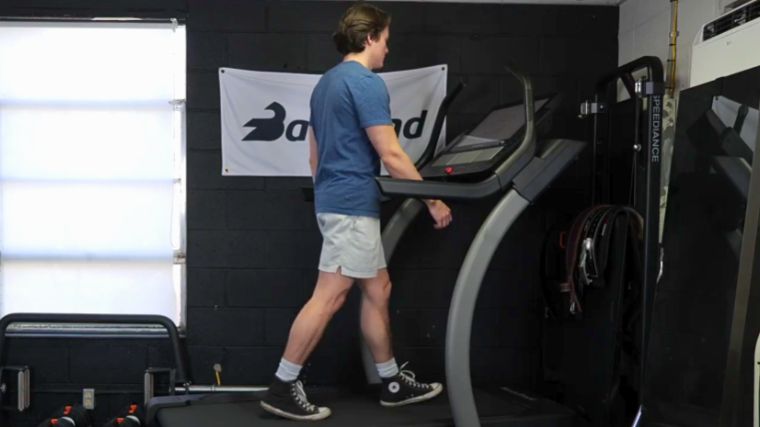Injuries, be they small or serious, happen to just about everybody. For super-jacked rehab specialist Jordan Shallow, rehab starts on day one.
“The real danger in the rehabilitation process is losing your fitness,” Shallow said while outlining his protocol to bounce back from a minor accident that led to a not-so-minor knee injury.
The operative word Dr. Shallow (DC) used to describe the state of his meniscus was “shredded.” But there’s no bed rest for the wicked. If you want to bounce back from an injury, you might want to pay heed to what Dr. Shallow is doing in his first two weeks.
[Related: How To Safely Train Legs With a Back Injury]
What To Do After a Knee Injury
As Shallow tells it, in early August, he stepped off a curb and, by unhappy chance, severely injured his meniscus. “A few weeks ago I shredded my right meniscus slipping on the sidewalk,” Shallow said on social media on Aug. 14, 2024.
“Since then, I’ve had my rehab hat on.” Here’s what Dr. Shallow is doing immediately after his meniscus injury to help speed up recovery:
Passive Movement
“You literally can’t sleep on rehab,” Shallow noted while endorsing moderate amounts of unloaded movement; passive flexion and extension of the knee, “…early and often. The days of ‘R.I.C.E.’ are long gone.”
- A 2020 literature review argued that the “rest, ice, compression, elevation” protocol is antiquated and, in some cases, may even slow down recovery due to limiting blood flow as well as the production of helpful hormones. (1)
Passive movement could entail activities like yoga or swimming, bending and straightening the knee while clasping your thigh, or something as simple as walking.
Walking
Shallow noted that he has been “walking…a lot” immediately following his knee injury. Walking is considered passive movement and, provided it does not cause or significantly worsen pain, can be a great way to restore confidence while also aiding recovery.
- A 2018 study argued that continuing with a workout routine after injury can help provide structure to your health habits and maintain a positive outlook. (2)
Getting your steps in will also help you maintain your general physical activity levels instead of resorting to sedentary behaviors while injured.

[Related: Best Running Shoes]
Exercise (to Tolerance)
“A couple days after my injury, I limped to the gym,” Shallow said. Not so he could wear a badge of honor or brag about how tough he is — training and rehabilitation are simply closer cousins than most people think.
“I pushed my threshold for comfort on the injured leg and then trained my ‘healthy leg’ to failure,” Shallow continued. “In the next week or so, I should be back to where I was pre-injury without losing any strength.”
- As long as you don’t overdo it, studies do show that continuing to train the injured area can speed up recovery. (3)
Other Voices: “Exercise increases blood flow, helping to shuttle inflammatory chemicals and waste products,” says Dr. Zachary Long, DPT and owner of The Barbell Physio. “Physical activity also releases endorphins, which have a pain-relieving effect all their own.”
Your First Move
What’s the common thread here? Taking an active role in your own rehabilitation, rather than letting time do all the work. Contemporary best practices for injury rehab align with the old adage; motion is lotion.
Before you pack up your gym bag, remember that all injuries are different, and what works for Dr. Shallow may not be relevant for you. Your best bet is to consult with a qualified physician instead of trying to mend an injury yourself.
Still, it’s helpful to see how the pros tackle things. For Dr. Shallow, falling off a curb is just a speed bump.
References
- Scialoia, Domenic & Swartzendruber, Adam. (2020). The R.I.C.E Protocol is a MYTH: A Review and Recommendations thesportjournal.org/article/the-r-i-c-e-protocol-is-a-myth-a-review-and-recommendations.
- Strömbäck E, Aasa U, Gilenstam K, Berglund L. Prevalence and Consequences of Injuries in Powerlifting: A Cross-sectional Study. Orthop J Sports Med. 2018 May 14;6(5):2325967118771016. doi: 10.1177/2325967118771016. PMID: 29785405; PMCID: PMC5954586.
- Welch N, Moran K, Antony J, Richter C, Marshall B, Coyle J, Falvey E, Franklyn-Miller A. The effects of a free-weight-based resistance training intervention on pain, squat biomechanics and MRI-defined lumbar fat infiltration and functional cross-sectional area in those with chronic low back. BMJ Open Sport Exerc Med. 2015 Nov 9;1(1):e000050. doi: 10.1136/bmjsem-2015-000050. PMID: 27900136; PMCID: PMC5117021.
Featured Image: @the_muscle_doc / Instagram